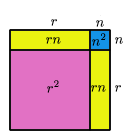Copyright © University of Cambridge. All rights reserved.
'Algebra from Geometry' printed from https://nrich.maths.org/
Show menu
Michael Brooker tackled the problem Bull's Eye and noticed something interesting when finding the area of a ring, which he has followed up. The result he found will be familiar to many older mathematicians.

Michael could see that the formula for the area of a ring must be
pi(R 2 - r 2 ). What he noticed was that in
the examples he worked out, the area also appeared to be pi(R+r).
This interested him, and he realised that you can find the
difference between numbers with consecutive square roots by adding
the roots:
144 - 121 = 23 = 12 + 11
Michael realised that this result is the reason why the second
formula works for rings where R = r + 1, and tried to prove
why.
He used a geometrical method to show that (r + 1) 2 = r
2 + 2r + 1:

So, if R = r + 1,
R 2 - r 2 = (r 2 + 2r + 1) - r
2 = 2r + 1 = R + r
We asked Michael what happened if the ring was 2 wide, or 3 wide.
Could he find an alternative formula for these rings, similar to
the simple one he found above? He started by trying some examples,
to see if he could spot anything interesting.
| r | R | area | width | R+r |
|---|---|---|---|---|
| 2 | 4 | 12pi | 2 | 6 |
| 2 | 5 | 21pi | 3 | 7 |
| 2 | 6 | 32pi | 4 | 8 |
Have you spotted what Michael did?
He then set out to prove that the formula for the area of a ring is
pi(R - r)(R + r)
Michael ignored the pi, and tried to show that
R 2 - r 2 = (R - r)(R + r).
This result is known as "the difference of two squares". It is a
very useful result, and Michael did well to find out about it for
himself.
He introduced the letter n for the width, so R = r + n, and then
rewrote the formulas above using r and n instead of r and R.
(R - r)(R + r) = n(r + n + r) = n(2r + n)
R 2 - r 2 = (r + n) 2 - r
2 = (r + n)(r + n) - r 2
Even if you don't know how to do (r + n)(r + n), you can probably
see what it is from the diagram below.

So (r + n)(r + n) - r 2 = r 2 + rn + rn + n 2 - r 2 = 2rn + n 2 = n(2r + n)
So R 2 - r 2 = (R - r)(R + r), and Michael has proved the result. Well done!
You may like to look at a couple of problems which are based on the the "Difference Of Two Squares" result: What's Possible? and Plus Minus